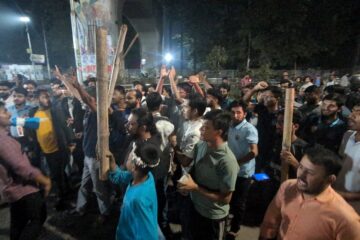A tragic accident on Sunday claimed the life of Abul Kalam Azad, a young man who was struck by a falling bearing pad, an essential component designed to absorb vibration in metro rail operations, near Dhaka’s Farmgate metro station.
The incident led to a temporary suspension of metro rail services for nearly two and a half hours and reignited concerns about the safety and structural integrity of the country’s first metro system.
This marks the second such failure at the same location in just over a year.
A similar bearing pad detachment occurred in September 2024, raising alarms among engineers and transit experts.
Both incidents took place at a curve in the track, a section known to exert additional pressure on the infrastructure.
Experts believe this design feature may be contributing to the recurring failures.
Dr Ahsanul Kabir, former head of Buet’s Civil Engineering Department, told the Dhaka Tribune that tangential forces at curved sections could be causing the bearing pads to shift.
He said that the pads on Dhaka’s metro rail are not properly anchored, which may explain why the same spot has witnessed repeated failures.
Kabir recommended tighter installation protocols, especially in curved areas, to prevent further accidents.
Professor Md Hadiuzzaman of Buet’s Accident Research Institute elaborated on the technical role of bearing pads: “The bearing pad is designed to compress slightly as a train passes over it and then return to its original shape. When the viaduct fails to return to its normal position, it suggests that the bearing pad has either lost functionality or fallen off.”
He warned that compromised bearing pads could threaten the stability of viaduct joints and even endanger the supporting pillars.
Hadiuzzaman emphasized the need for rigorous pre-installation testing and called for a thorough investigation into the cause of the failure.
Function of bearing pads
Bearing pads serve a critical function in metro rail systems.
Positioned between viaducts and columns, they absorb vibrations, support heavy loads, and allow structural flexibility, particularly during seismic events.
Their role becomes even more crucial at curved sections, where lateral and downward forces converge.
When these components fail, the load distribution is disrupted, increasing the risk of structural damage and posing serious hazards to both passengers and pedestrians.
In response to the incident, Road and Rail Adviser Fouzul Kabir Khan announced the formation of a five-member investigation committee, led by Bridge Division Secretary Mohammad Abdur Rouf.
The committee is expected to submit its findings within two weeks.
Experts are urging authorities to adopt advanced securing methods for bearing pads, particularly at vulnerable curves, and to consider using metal-reinforced or pressure-resistant materials.
They also recommend installing monitoring systems to detect abnormal movement and enforcing mandatory safety certifications, maintenance protocols, and insurance policies to safeguard public infrastructure and lives.



